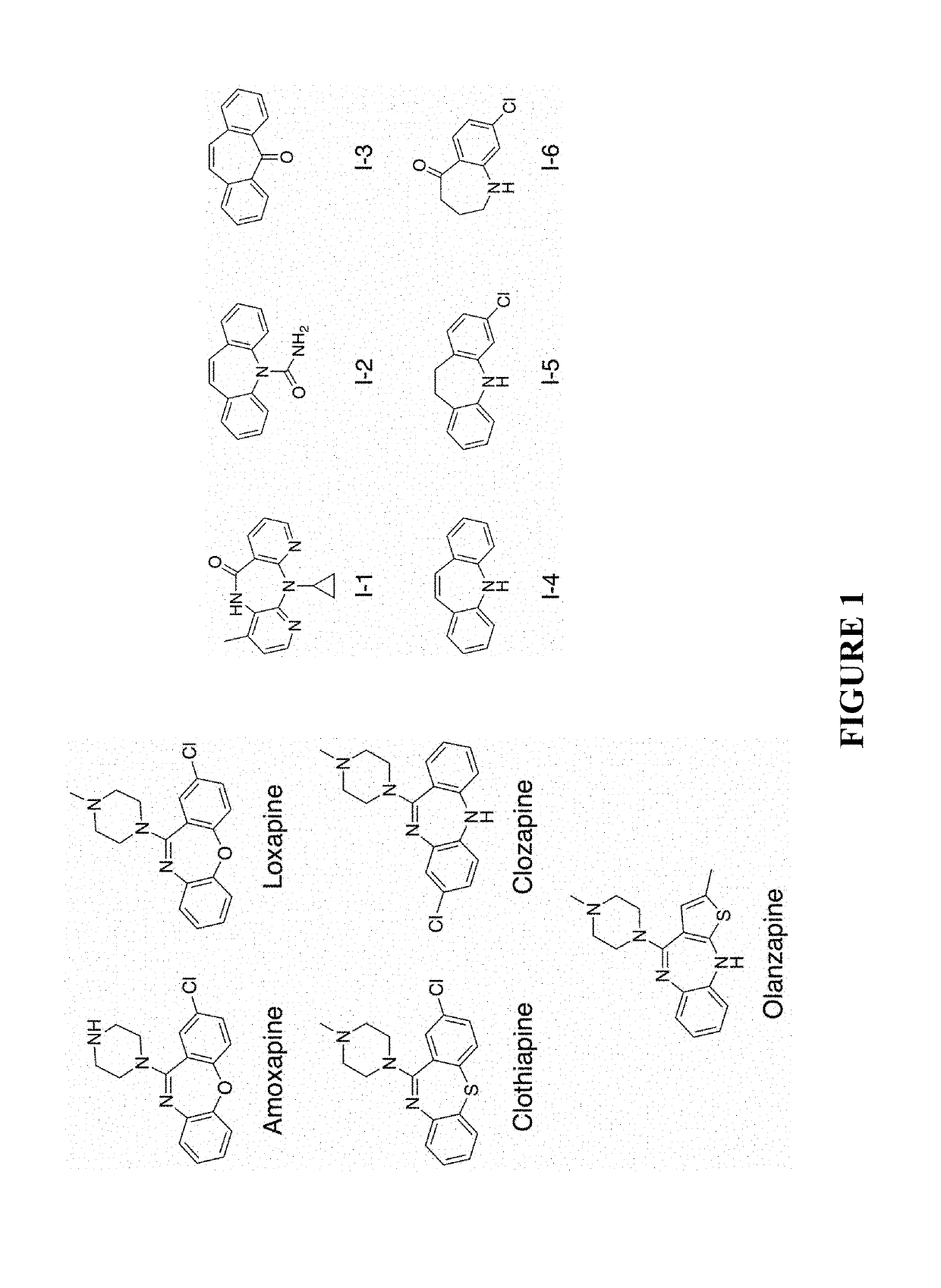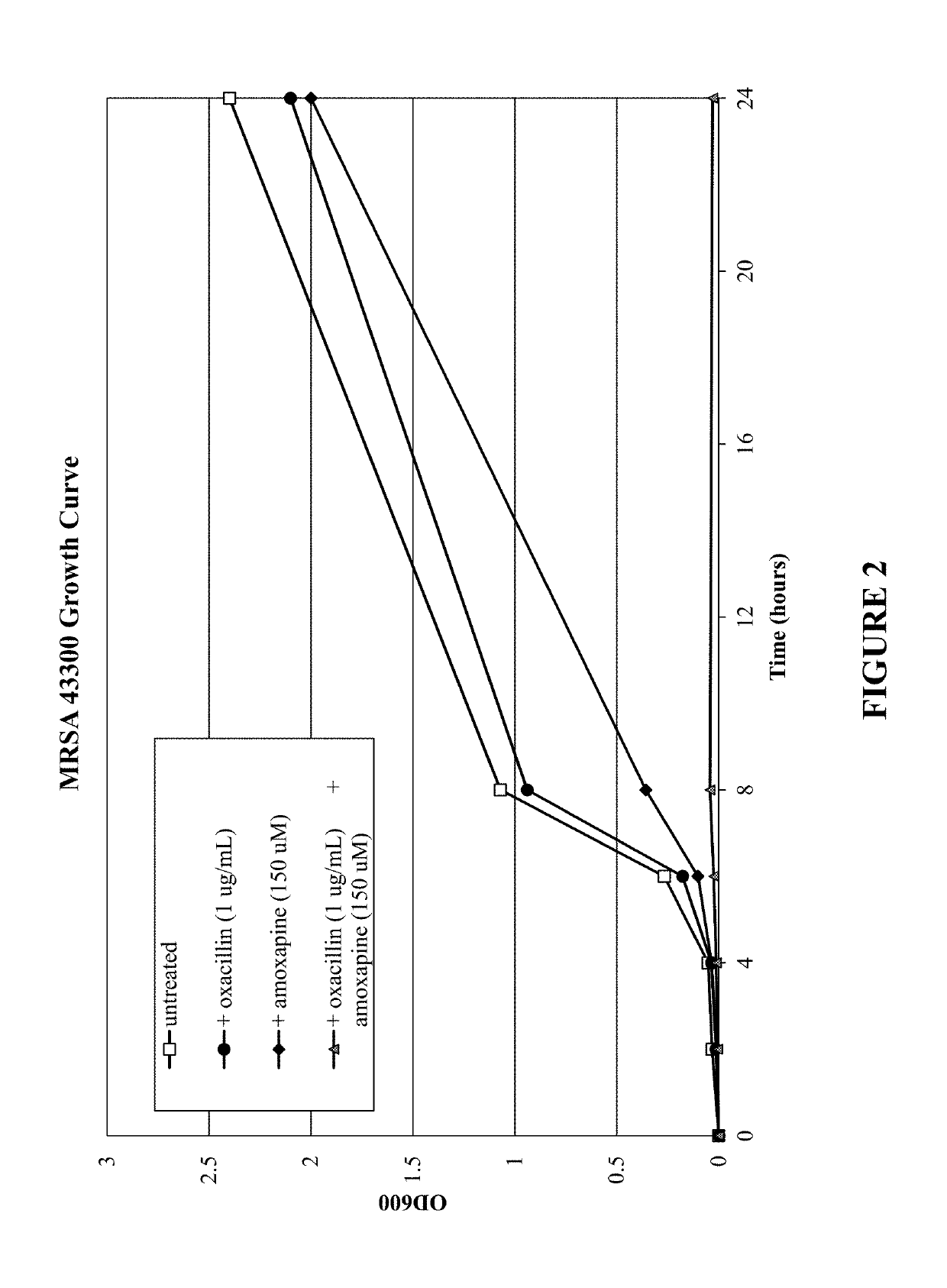Small-molecule adjuvants for antibiotics to address antibiotic resistance
a technology of antibiotic resistance and small molecules, which is applied in the direction of antibacterial agents, saccharide peptide ingredients, medical preparations, etc., can solve the problems of inability to prevent or disperse bacterial biofilms, the overall infection burden of indwelling medical devices is expected to rise, and the effectiveness of known antibiotics is enhanced. , to achieve the effect of preventing biofilm formation and enhancing the effectiveness of known antibiotics
- Summary
- Abstract
- Description
- Claims
- Application Information
AI Technical Summary
Benefits of technology
Problems solved by technology
Method used
Image
Examples
example 1
[0124]Tricyclic amine antidepressants based on the amoxapine scaffold were studied to evaluate if they were capable of disarming MRSA resistance mechanisms and restoring the efficacy of β-lactam antibiotics. The minimum inhibitory concentration (MIC) of each compound against the studied S. aureus strains was determined (see Table 1) using a standard broth microdilution protocol. See Jorgensen, J. H.; Turnidge, J. D. In Manual of Clinical Microbiology, Eleventh Edition; American Society of Microbiology, 2015, which is incorporated herein by reference in its entirety. The compounds were then analyzed for antibiotic repotentiation activity. The minimum inhibitory concentration of oxacillin, a β-lactam antibiotic, against planktonic bacteria was determined in the presence and absence of these compounds was determined at concentrations of 75 μM and 150 μM (≤25% of the amoxapine MIC) using a standard broth microdilution protocol. See Jorgensen, J. H.; Turnidge, J. D. In Manual of Clinical...
example 2
[0134]Dibenzazepine and dibenzoxazepine derivatives based on compound I-5 were synthesized and analyzed for antibiotic adjuvant activity. Exemplary compounds tested are shown in FIG. 5. MICs of compounds II-2 through II-6 in S. aureus 43300 were all >200 μM. These iminodibenzyl derivatives were tested against S. aureus 43300 with oxacillin and the results are shown below in Table 6.
TABLE 6MIC of oxacillin in combination with iminodibenzyl derivatives inS. aureus 43300 (MRSA)+50 μM compoundMICFoldCompound(μg / mL)Reduction—32—I-5216II-2321II-3162II-4321II-584II-6321
[0135]Further derivatives (II-7 through II-10, shown in FIG. 5) were also analyzed. MICs of compounds II-7 through II-10 in S. aureus 43300 were all >200 μM. These dibenzoxazepine derivatives were tested against S. aureus 43300 with oxacillin and the results are shown below in Table 7.
TABLE 7MIC of oxacillin in combination with iminodibenzylderivatives in S. aureus 43300 (MRSA)+50 μM compoundMICFoldCompound(μg / mL)Reduction—3...
example 3
[0136]Based on the structural similarities between the dibenzazepine scaffold and the benzocycloheptapyridine scaffold, loratadine and desloratadine, as well as derivatives of loratadine (as shown in FIG. 6) were analyzed for adjuvant activity in several strains of S. aureus. MICs for loratadine and desloratadine with various S. aureus strains are provided below in Table 8 and were all >200 μM, as shown.
TABLE 8MICs of loratadine and desloratadineMICs in CAMHB (μM)Bacterial StrainLoratadineDesloratadineS. aureus ATCC 29213>200>200S. aureus* ATCC 43300>200>200S. aureus* USA100>200>200S. aureus* USA300>200>200S. aureus** NR-49120>200>200*denotes methicillin resistant strain**denotes vancomycin & methicillin resistant strain
[0137]Table 9, provided herein below, provides MICs of oxacillin alone and in combination with loratadine and desloratadine. Loratadine showed potent potentiation of oxacillin across several medically relevant strains of antibiotic resistant S. aureus. USA100 is a co...
PUM
| Property | Measurement | Unit |
|---|---|---|
| time | aaaaa | aaaaa |
| sizes | aaaaa | aaaaa |
| diameter | aaaaa | aaaaa |
Abstract
Description
Claims
Application Information
 Login to View More
Login to View More - R&D
- Intellectual Property
- Life Sciences
- Materials
- Tech Scout
- Unparalleled Data Quality
- Higher Quality Content
- 60% Fewer Hallucinations
Browse by: Latest US Patents, China's latest patents, Technical Efficacy Thesaurus, Application Domain, Technology Topic, Popular Technical Reports.
© 2025 PatSnap. All rights reserved.Legal|Privacy policy|Modern Slavery Act Transparency Statement|Sitemap|About US| Contact US: help@patsnap.com



